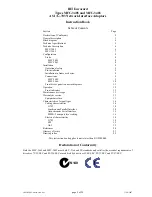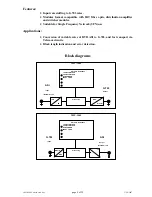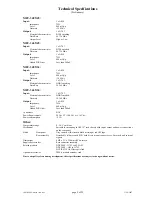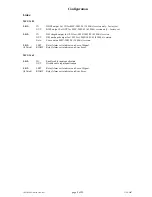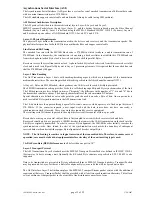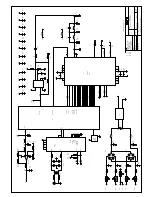
3465&3485-mfc.ib.rev4.doc
page 15 of 22
17/10/2007
Asynchronous Serial Interface (ASI)
The Asynchronous Serial Interface (ASI) provides a system for serial encoded transmission of different data rates
with a constant transmission rate of 270 Mbit/s.
The ASI standard supports coaxial cable and multi-mode fibre-optic cable (using LED emitters).
ASI Protocol Architecture Description
The ASI protocol is divided into three architectural layers: Layer-0, Layer-1 and Layer-2.
MPEG Transport Packets form the top layer (Layer 2), and the bottom layers are based upon the Fibre Channel
Standard (Layers 1 and 0). Layer 2 is defined using the MPEG-2 Standard ISO/IEC 13818-1 (Systems). Layers 1
and 0 are based upon a subset of ANSI Standard X3T11/ Levels FC-1 and FC-0.
Layer-O: Physical Requirements
The physical Layer defines the transmission media, the drivers and receivers, and the transmission speeds. The
physical interface provides for both LED-driven multimode fibre and copper coaxial cable.
Line Rates and Bit Timing
The encoded line rate with the 8B/10B block code is 270 Mbit/s which results in a media transmission rate of
270 MBaud. At the transmitter, the serialisation is done using a fixed oscillator to establish this 270 MBaud rate
from which a phase-locked Byte clock is derived and used to shift in parallel Bytes.
Receivers recover the serial transmission clock. A phase-locked Byte clock is derived from this recovered serial bit
clock and is used to shift parallel Bytes out to Layer- 1 processing elements. It is required that the encoded line rate
shall be 270 MBaud
±
100 ppm.
Layer-1 Data Encoding
The ASI Transmission Layer 1 deals with encoding/decoding aspects, which are independent of the transmission
medium characteristics. The encoding method utilised is specified in the fibre channel document X3T11
At Layer-1, Bytes are 8B/10B coded, which produces one 10-bit word for each 8-bit Byte presented.
The 8B/10B transmission coding provides for both a self checking capability and Byte synchronisation of the link.
The 10B transmission code is defined in terms of "disparity": the difference in the number of "1" bits and "0" bits in
the transmitted serial data stream. The disparity characteristics of the code maintain DC balance.
Special characters are defined as extra code points beyond the need to encode a Byte of data. One in particular is
used to establish Byte synchronisation in the ASI transmission link.
The 10-bit words are then passed through a parallel-to-serial converter, which operates at a fixed output bit-rate of
270 Mbit/s.. If the converter requests a new input word and the data source does not have one ready, a
synchronisation word is inserted. These sync words are ignored by receive equipment.
The resulting serial bit stream is passed to the output driver circuit for coaxial or fibre-optic cable.
Receive data arriving on a coaxial cable or fibre is first coupled to a circuit, which recovers clock and data.
Recovered serial data bits are passed to a 10B/8B decoder that converts the 10-bit transmission words back into the
8-bit Bytes originally transmitted. In order to recover Byte alignment, the 10B/8B decoder initially searches for
synchronisation words. Once found, the start of the synchronisation word marks the boundary of subsequent
received data words and establishes proper Byte-alignment of decoder output Bytes.
NOTE - The ASI coding is sensitive to logical inversion of the transmitted bits. Therefore, to ensure correct
operation, care must be taken that equipment interface circuitry of the non-inverting type is used.
The
Bit-Error-Rate (BER) Performance
shall be less than one part in 10
13
.
Layer-2 Transport Protocol
The ASI Transmission Layer-2 standard uses the MPEG-2 Transport Stream Packet as defined in ISO/IEC 13818-1
(Systems) as its basic message unit. Optionally the RS coded Byte structure as specified in ETS 300 429 is also
supported.
Data to be transmitted are presented in Byte-synchronised form as MPEG-2 Transport packets. Transport Packets
may be presented to Layer-2 either as a burst of contiguous Bytes, or as individual Bytes spread out in time.
The ASI Interface Layer-2 definition employs the MPEG-2 Transport Stream packet syntax with the additional
requirement that every Transport Packet shall be preceded with at least two synchronisation characters. This allows
re-sync within one transport packet in the event that a line disturbance causes loss of sync.


